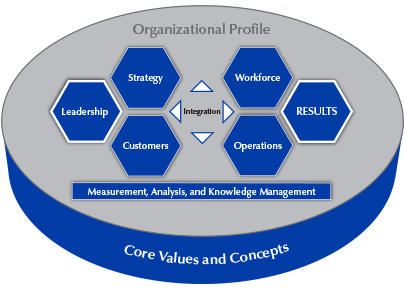Blogrige
The Official Baldrige Blog
What Happened to the Leading Edge of Validated Management Practice?

Baldrige Framework Diagram
For those very careful readers of the Baldrige Excellence Framework, you will notice a subtle change in 2015-2016. We no longer refer to the framework as representing the leading edge of validated management practice. Are you now thinking we have abandoned our guiding principle for revision of the Criteria? Are you wondering what guides us now? Read on!
Our definition of management has always been in the context of organizational performance management which begins with the role of senior leaders. Over the course of time the word "management" has taken on a meaning in many organizational environments as the work of front-line and mid-level supervisors and decision makers, in contrast to leadership who set the strategy and inspire the organization to achieve. The first few sentences in the definition of management in the Business Dictionary illustrate this point, "The organization and coordination of the activities of a business in order to achieve defined objectives. Management is often included as a factor of production along with machines, materials, and money." While that is clearly not the context in which our guiding principle is viewed, it is the reality of many organizations today and we must be clear in our intent. Baldrige starts with the role and actions of senior leaders and encompasses the strategic and operational aspects of organizational success. That posture is reflected, more clearly we believe, in our new guiding mantra contained in the 2015-2016 Baldrige Excellence Framework. The Baldrige Framework represents the leading edge of validated leadership and performance practice.
Baldrige starts with the key roles of leadership: setting vision and values, exhibiting high ethical conduct, communicating, and guiding performance to achieve the mission. And it is an a-to-z guide that ends with measuring all key dimensions of organizational performance: product, process, customer, workforce, leadership and governance, and financial and market. It is also an organizational maturity model that unites the leadership with performance in an integration dimension that links results to the responsibilities of leaders and their role in creating change. Baldrige represents the leading edge of validated leadership and performance practice.
We have not abandoned our guiding principle, we have made it more explicit. Is your organization on this journey?
About the author
Related Posts
Comments
- Reply





